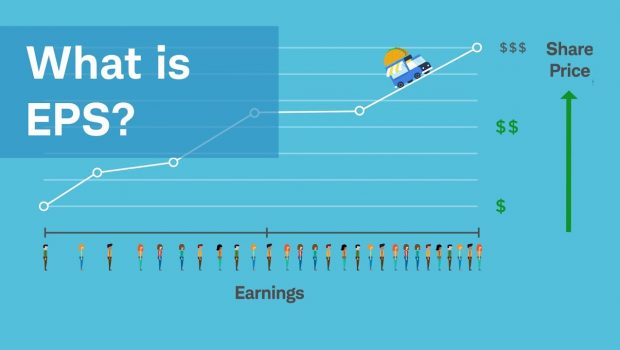How The EPS Formula Can Help You Get Better Results With Your Trading
Earnings per share (EPS) is an extremely important financial measure, which showcases a company’s profitability. It’s obtained by dividing the firm’s net income with the overall number of outstanding shares. It’s a powerful tool that market participants utilize frequently to gauge a company’s profitability before purchasing its shares.
Description
EPS refers to a portion of a firm’s profit that’s allocated to each share of the stock. This concept is of more importance to investors as well as those who trade in the stock market. Higher EPS values mean better profitability. When calculating the EPS, it’s advisable to utilize the weighted ratio, since the number of outstanding shares can change over time.
Methods Of Calculating EPS
EPS= Net income after Deducting Taxes/Total Number of Shares Outstanding
Or
Weighted EPS= (Net Income after Deducting Taxes- Total Dividends)/ Overall Number of Shares Outstanding
The diluted version of the Earnings Per Share Formula includes convertible shares plus warrants listed under outstanding shares. It’s often considered to be a broader version of the basic EPS ratio.
For investors who’re primarily interested in a stable income source, the EPS ratio provides them with important information regarding the company’s business endeavors and its existing dividend. Though EPS is an extremely important and powerful tool for investors, it shouldn’t be looked at in isolation.
The EPS value of one company should always be evaluated in relation to other firms in the same industry so as to make a more prudent investment decision. In simple terms, earnings per share refer to a portion of the firm’s profit that’s allocated to each outstanding share.
Importance of EPS to Investors
Due to the following reasons, earnings per share (EPS) is a very important metric for investors who want to take their business experiences to another level.
Measuring Profitability
As a metric, earnings per share is extremely important for measuring a company’s profitability. In the entire concept of fundamental analysis, EPS has been proven to be the most effective metric as it isolates net income to determine exactly what stakeholders are gaining by partnering with the company.
A consistently growing EPS shows that the investors are getting a share of the organization’s growing profits consistently. In addition, growing EPS also means that the company is creating more value for its investors. On the other hand, a consistently falling EPS implies financial trouble, consistent losses, minimal profits, and eroding investor value.
With the EPS formula, you can readily determine the amount of profit a company makes per outstanding share as well as the amount of profit that’s accrued to a shareholder.
Divided Layout Indicator
Dividends refer to the portion of an organization’s profits that are disbursed to the stakeholders. Most investors enjoy the steady income that comes along with the dividends. Plus, investors also consider dividends as a positive sign of growth in the future for the company. However, it’s important to note the firm can only give out dividends if it has surplus earnings per share. Even if dividends aren’t directly related to earnings per share, it’s commonly seen like those companies which have consistently stable EPS, pay dividends to their stakeholders.
Though dividends are highly subjective and most decisions are made before dividend payout, investors who’re looking for dividend income must consider evaluating a company’s earnings per share before investing.
Determines the P/E Ratio
Other than the profitability of a company, investors are interested in understanding the value that certain shares bring to their portfolio. With the P/E ratio, investors can effectively value the shareholding. And the key determinant of this ratio is EPS.
To calculate the P/E ratio, you need to dive the price per equity share by the company’s earnings per share.
P/E ratio = Price per Equity Share/ EPS (Earnings per Share)
So, how important is EPS to this metric? Let’s find out.
Suppose company A owns one equity share costing $100 and its earnings per share for the year 2016 is $20. Then its P/E ratio will be obtained by dividing 100 by 20, and the result is 5. What this means is that at current profitability, the company firm will earn its market price per equity share in the next 5 years.
Now let’s consider company B, which has a market price per equity share of $1000 and an EPS value of $100. Its P/E ratio will be 1000 divided by 100, which is equal to 10. So, it will take investors over 10 good years to recover their investments in the company.
If EPS was the only factor to be taken into consideration, company B looks better with an EPS value of $100. But looking at the P/E ratio, company A appears to be the best bet as it offers a faster return on investment.
Regardless of its simplicity, EPS as a metric is remarkably powerful and concentrates important company information in a single number. Plus, it allows investors to evaluate investments across numerous sectors and industries. It also plays an important role in charting a company’s financial performance. And this makes it possible for investors to make informed decisions. Though you must perform detailed fundamental as well as market analysis before making huge investments in a company, EPS by itself can also tell quite a lot about the company’s value and profitability.
The cash EPS, also referred to as the cash earnings per share, determines the amount of money each share of a firm’s stock contributes to the cash flow. Though the cash EPS is commonly expressed as a figure, it’s actually a dollar amount. A company with a higher cash EPS value has well-performing stocks that are generating real cash for the business.
Key Takeaways
EPS is a common financial ratio. It’s easily accessible to investors since most companies provide the EPS figure on their annual reports. As an investor, this is actually the first ration that you need to look at because it’s easy to understand and provides a clear indication of the company’s profitability.
















